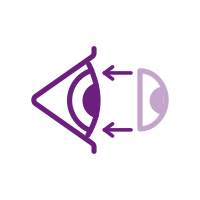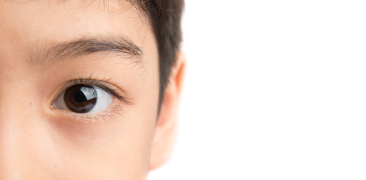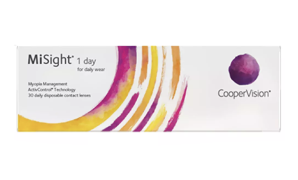What is
Myopia?
Myopia, also known as near-sightedness or short-sightedness, is a disease that makes distant objects appear blurry.1 It can interfere with children’s quality of life, making it harder for them to participate in school, sports, or other daily activities.2,3 Myopia can progress rapidly, particularly in younger children, so it is important to start treatment as soon as it is diagnosed.4

Get to know the symptoms of myopia
01
Close-up objects look clear but distant objects are blurry
02
Complaints of headaches
03
Tired or strained eyes
04
Squinting to see properly
05
Moving closer to the screen
06
Poor concentration

Did you know?
Even a 1.00 dioptre increase in myopia can lead to a 67% increase in the risk of developing myopic maculopathy.5
Start myopia treatment early






Go beyond treating myopia with MiSight® 1 day

See the Science
ActivControl™ Technology in MiSight® 1 day treatment is dual-purpose: it provides clear vision and helps control myopia progression.6


See the Success
9 out of 10 children prefer MiSight® 1 day contact lenses to spectacles, with children as young as 8 years old being able to confidently apply and remove them on their own.7


See the Safety
MiSight® 1 day has a strong safety profile as it's a 1-day lens.11 It is a convenient, single-use lens that doesn't require cleaning, solutions, or storage.

Go beyond treating myopia with MiSight® 1 day

Powered by science
ActivControl™ Technology in MiSight® 1 day treatment is dual-purpose: it provides clear vision and helps control myopia progression.6


Preferred by children
9 out of 10 children prefer MiSight® 1 day contact lenses to spectacles, with children as young as 8 years old being able to confidently apply and remove them on their own.7


Trusted by parents
75% of parents believe that MiSight® 1 day is easy to use and safe for children as young as 8 years old.8

Begin your child’s journey with MiSight® 1 day


Act now to secure a better future for your child
- MiSight® 1 day is the longest soft contact lenses study among children (7 years).
- Slows down myopia progression by approximately 50%.
- 9 out of 10 children prefer MiSight® 1 day contact lenses to spectacles.10
- Strong safety profile as they are 1-day lenses.11
Make MiSight® 1 day your first choice for myopia control.


Explore more

Vision Simulator
See the world through the eyes of a child with myopia.

Further Reading
Find resources to learn more about myopia from experts and medical professionals.

Could your child be short-sighted?
Discover the causes of myopia and signs you should look out for.

Myopia Risk Assessment Tool
Take a short quiz to assess your child’s risk of developing myopia.

Introducing MiSight® 1 day
Start with MiSight® 1 day, the proven treatment to help slow myopia progression in children.

Contact lenses for first-timers
Learn how to apply and remove your MiSight® 1 day contact lenses.
References
1. American Academy of Ophthalmology. Nearsightedness: What Is Myopia? [Internet] [cited 2022 Sep 06] Available from: aao.org/eye-health/diseases/myopia-nearsightedness
2. Lamoureux EL et al. Myopia and quality of life: The Singapore Malay Eye Study (SiMES). Invest Ophthalmol Vis Sci. 2008;49(13):4469.
3. Chua SYL, Foster PJ. The Economic and Societal Impact of Myopia and High Myopia. In: Ang M., Wong T. (eds) Updates on Myopia. 2020. Springer, Singapore.
4. Zadnik K et al. Factors associated with rapid myopia progression in school-aged children. Invest Ophthalmol Vis Sci. 2004;45(13):2306.
5. Bullimore MA, Brennan NA. Myopia control: why each diopter matters. Optom Vis Sci. 2019;96(6):463-5.
6. Chamberlain P et al A 3-year Randomized Clinical Trial of MiSight Lenses for Myopia Control. OptomVis Sci 2019;96:556-567.
7. Sulley A et al. Wearer experience and subjective responses with dual focus compared to spherical, single vision soft contact lenses in children. OptomVis Sci 2019; 96: E-abstract 195252.
8. CVI data on file, 2019. Global survey by Decision Analyst with 1,009 parents in UK, Canada, Germany, Spain, Hong Kong, Australia/NZ.
9 Walline JJ et al. Benefits of contact lens wear for children and teens. Eye Contact Lens. 2007;33(6 Part 1 of 2):317-21.
10. Arumugam B, Bradley A, Hammond D, Chamberlain P. Modelling Age Effects of Myopia Progression for the MiSight 1 day Clinical Trial. Invest. Ophthalmol. Vis. Sci. 2021;62(8):2333.
11. Woods, J., Jones, D., Jones, L., Jones, S., Hunt, C., Chamberlain, P., & McNally, J. (2021). Ocular health of children wearing daily disposable contact lenses over a 6-year period. Contact Lens and Anterior Eye.







